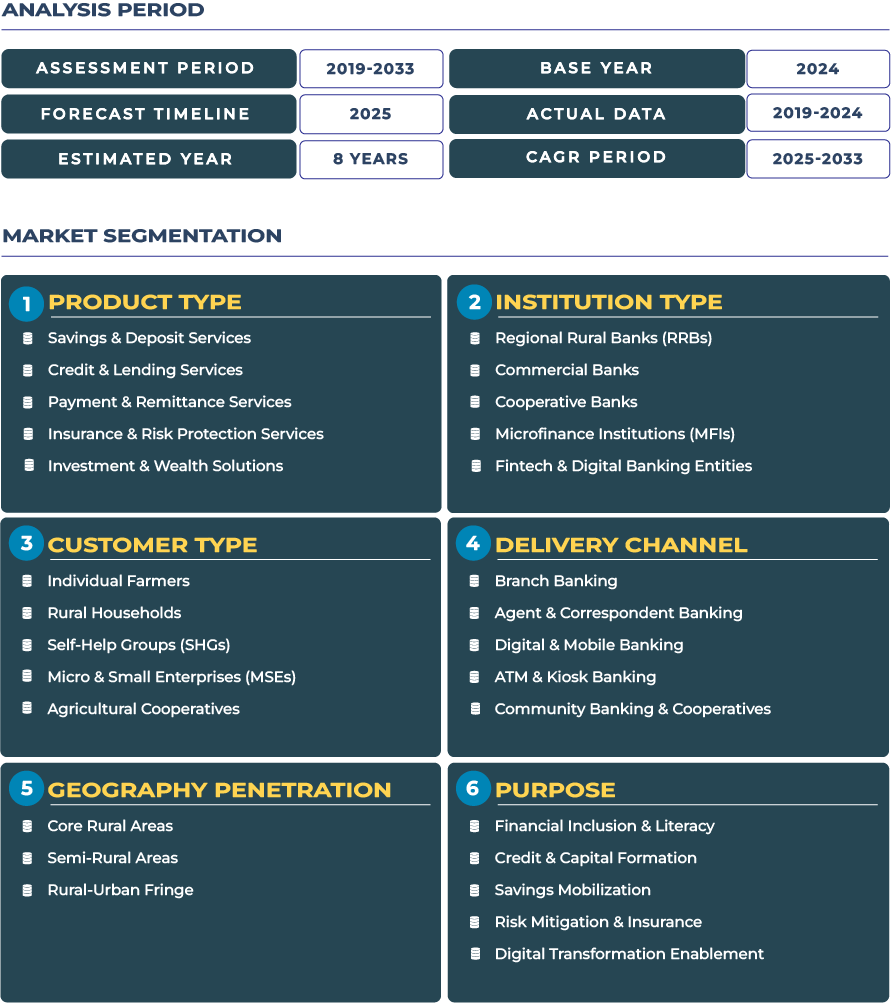Australia Rural Banking Market Embraces Carbon-Linked Finance for Climate Resilience
Australia rural banking market is entering a defining era where climate adaptation, carbon-credit integration, and sustainability-linked lending are reshaping traditional agri-finance. With banks now embedding environmental metrics into loan structures, rural finance is transitioning from transactional credit to a model that rewards resilience. As of 2025, the market is valued at USD 8.6 billion and is projected to reach USD 10.6 billion by 2033, expanding at a CAGR of 2.7% between 2025 and 2033. This moderate yet steady growth reflects a sector recalibrating toward long-term climate and carbon neutrality objectives.
Note:* The market size refers to the total fees/revenue generated by banks through various services.
The Australian Department of Agriculture, Fisheries and Forestry has prioritized climate-resilient rural economies, introducing incentives for agribusinesses that adopt sustainable practices. At the same time, commercial lenders and regional banks are embedding carbon-offset mechanisms in Credit & Lending Services portfolios, rewarding carbon farming and drought-resilient operations with better financing terms. This shift is not only transforming rural lending but also reinforcing the role of Investment & Wealth Solutions in promoting regenerative agriculture. By linking finance to measurable sustainability outcomes, rural banks are building a more climate-proof ecosystem that aligns with Australia’s net-zero agenda.
Australia Rural Banking Market Outlook: Carbon-Linked Finance Becomes the Lifeline for Australia’s Rural Sector
Australia rural banking industry has been shaped by climate variability, frequent droughts, and the rising cost of adaptation. In response, lenders are leveraging carbon-linked finance as both a risk mitigation and revenue diversification strategy. The emerging model enables farmers and pastoral operations to access loans tied to carbon sequestration performance, an innovation that turns climate responsibility into a credit asset. This framework is increasingly supported by programs such as Clean Energy Regulator’s Carbon Farming Initiative, which allows rural borrowers to earn tradeable carbon credits through sustainable land practices.
From a macroeconomic perspective, the stable Australian dollar, coupled with proactive monetary policy from the Reserve Bank of Australia, provides a conducive environment for rural credit expansion. Despite geopolitical uncertainty and lingering supply chain disruptions, financial institutions are focusing on Insurance & Risk Protection Services to buffer farmers from climatic and market shocks. The integration of technology, such as satellite imagery for carbon measurement and digital platforms for credit scoring, has improved the accessibility and accountability of rural credit. As sustainability finance evolves, Australia rural banking landscape stands as a model for climate-integrated lending across the Asia-Pacific region.
Drivers & Restraints: How Climate Policy and Distance Shape Australia’s Rural Finance Future
Government Incentives and Pastoral Modernization Propel Growth
The key growth driver in the Australia rural banking sector is the increasing convergence of public policy, agritech, and financial innovation. Government-led drought relief and concessional loan schemes have expanded liquidity for rural borrowers. The FarmHub initiative, for instance, connects farmers with drought assistance and financial literacy programs, stimulating rural credit activity. Additionally, large-scale pastoral operations, especially in Queensland and New South Wales, are adopting specialist finance solutions tailored for livestock management, water efficiency, and carbon accounting. Financial institutions are increasingly offering sustainability-linked credit lines, where loan rates are tied to measurable ecological outcomes, creating an alignment between profitability and environmental responsibility.
Distance, Climate Volatility, and Credit Risk Constrain Growth Momentum
Despite these advancements, the rural banking market faces persistent challenges. Australia’s vast geography and sparse population density drive up the cost of service delivery, particularly in remote regions. This logistical complexity makes it difficult for banks to scale branch-based models or maintain frequent field assessments. Moreover, climate volatility, ranging from extreme droughts to bushfires, adds layers of uncertainty to rural income streams. Unpredictable yields make long-term credit repayment riskier, discouraging aggressive loan expansion. Additionally, fluctuating global commodity prices continue to strain cash flow for agribusiness borrowers. These structural issues limit the sector’s ability to achieve rapid growth despite favorable policy conditions and technological enablement.
Trends & Opportunities: Digital Carbon Banking and Resilient Finance Models Redefine the Landscape
Carbon Farming and Digital Agri-Wallets Lead the Trendline
One of the most transformative trends in Australia rural banking ecosystem is the rise of carbon farming as a collateral class. Banks are designing loan products that integrate carbon credits into repayment models, effectively turning ecological stewardship into financial equity. Digital agri-wallets are also emerging as essential tools for smallholders and cooperatives, enabling seamless management of subsidies, loan disbursements, and insurance claims. In states such as Victoria and Western Australia, digital rural banking adoption has increased significantly, supported by broadband connectivity and data-sharing agreements between agri-tech startups and local banks. This digitization is expanding financial inclusion while also embedding sustainability into everyday banking operations.
Opportunities in Carbon-Credit Lending and Drought Resilience Finance
Opportunities are ripe for institutions that can design and implement carbon-credit-backed lending models. By enabling farmers to earn and trade carbon credits, banks can enhance repayment security while supporting national sustainability targets. Similarly, financing drought-resilient pasture rehabilitation presents dual benefits, protecting yields and generating long-term carbon sequestration value. Regional lenders such as Westpac are piloting drought-linked insurance products and staged financing structures that release capital based on progress milestones. These initiatives are not only financially prudent but also critical for enhancing climate adaptation in rural Australia.
Competitive Landscape: Strategic Alliances Drive Innovation in Rural Credit Systems
The competitive landscape of Australia rural banking market is becoming increasingly dynamic as traditional banks, fintechs, and sustainability-focused lenders collaborate to deliver innovative financial products. Major banks such as Commonwealth Bank of Australia, Westpac, and National Australia Bank are actively integrating sustainability-linked metrics into lending frameworks. Their focus on Insurance & Risk Protection Services and Investment & Wealth Solutions aligns with evolving regulatory expectations from the Australian Securities and Investments Commission, which emphasizes responsible lending in climate-sensitive sectors. As rural lending transitions toward climate finance, these institutions are setting new benchmarks for transparency, resilience, and green credit transformation.







